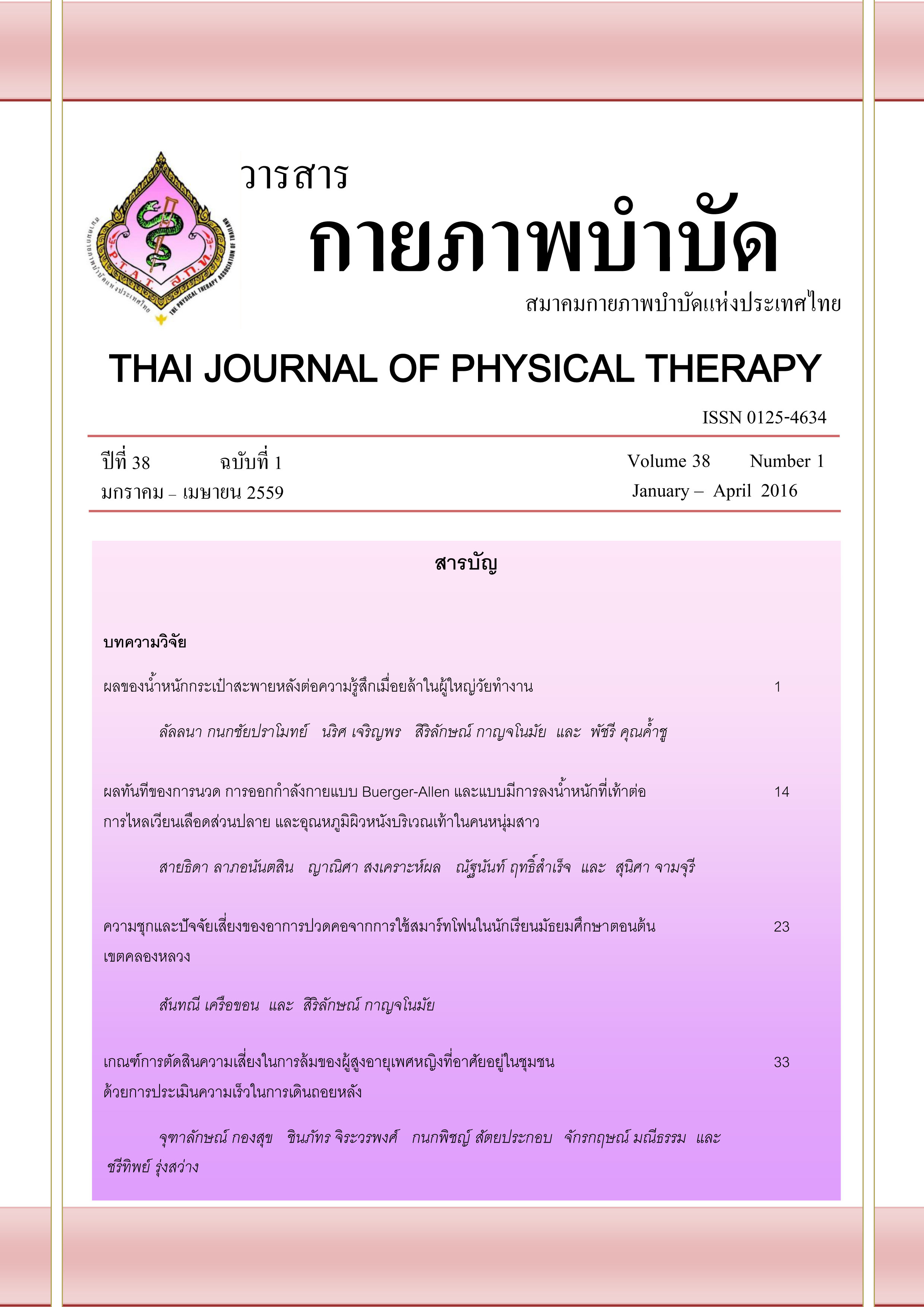ผลของน้ำหนักกระเป๋าสะพายหลังต่อความรู้สึกเมื่อยล้าในผู้ใหญ่วัยทำงาน
Main Article Content
บทคัดย่อ
การใช้กระเป๋าสะพายหลังเป็นรูปแบบหนึ่งที่นิยมเพราะสามารถลดความเสี่ยงต่อการปวดหลังหรือปวดคอ เนื่องจากน้ำหนักกระเป๋าจะช่วยกระจายแรงไปที่ร่างกายทั้งสองด้านเท่าๆกัน แต่ปัจจุบันพบว่าคำแนะนำในการใช้น้ำหนักของกระเป๋าสะพายหลังสำหรับผู้ใหญ่มีค่อนข้างน้อยและยังไม่มีความชัดเจนในคำแนะนำ ดังนั้นการศึกษาครั้งนี้จึงมีวัตถุประสงค์เพื่อเปรียบเทียบความรู้สึกเมื่อยล้าจากน้ำหนักกระเป๋าสะพายหลังที่ระดับต่างๆ ผู้เข้าร่วมการศึกษาประกอบด้วยอาสาสมัคร 48 คน ถูกแบ่งเป็น 2 กลุ่ม คือกลุ่มที่ไม่ใช้กระเป๋าสะพายหลัง (n=24) และกลุ่มที่ใช้กระเป๋าสะพายหลังเป็นประจำ (n=24) อาสาสมัครจะถูกประเมินความรู้สึกเมื่อยล้าก่อนและหลังการเดิน 10 นาทีขณะสะพายกระเป๋าที่มีน้ำหนักร้อยละ 0, 10, 15 และ 20ของน้ำหนักร่างกาย โดยใช้สถิติการทดสอบสมมติฐานของกลุ่มตัวอย่างสองกลุ่มที่เป็นอิสระจากกัน และการวิเคราะห์ความแปรปรวนแบบสองทางเมื่อมีการวัดซ้ำในการวิเคราะห์ข้อมูล ผลการวิจัยพบว่าการใช้กระเป๋าสะพายหลังที่มีน้ำหนักร้อยละ 10, 15 และ 20ของน้ำหนักร่างกายเป็นระยะเวลา 10 นาทีส่งผลต่อความเมื่อยล้าภายหลังการเดินอย่างมีนัยสำคัญทางสถิติในทั้งสองกลุ่ม ดังนั้น ผู้ใหญ่อายุระหว่าง 20-50 ปี ควรใช้กระเป๋าสะพายหลังที่มีน้ำหนักไม่เกินร้อยละ 10 ของน้ำหนักร่างกาย
Article Details
เอกสารอ้างอิง
2. Mohan M, Singh U, Quddus N, Effect of backpack loading on cervical and shoulder posture in Indian school children. Indian Journal of Physiotherapy and Occupational Therapy 2006; 0(0) (2006-10 - 2006-12).
3. Li JX, Hong Y, Robinson PD, The effect of load carriage on movement kinematics and respiratory parameters in children during walking. Eur J Appl Physiol 2003; 90: 35-43.
4. กานดา ใจภักดี. วิทยาศาสตร์การเคลื่อนไหว (Kinesiology). พิมพ์ครั้งที่ 3. สำนักพิมพ์ดวงกมล กรุงเทพฯ; 2542.
5. Chow DHK, Hin CKF, Ou D, Lai A, Carry-over effects of backpack carriage on trunk posture and repositioning ability. Int J Ind Ergonom 2011; 41: 530-5.
6. Lin CS, Chen FY, Huang YS, Cho CY, Effects of backpack loads on neck-trunk muscle activation among office workers, Proceedings of the 30th Annual Conference of Biomechanics in Sports – Melbourne 2012; 99-102.
7. Safikhani H, Kamalden T, Amri S, Ahmad M, The effect of different backpack loading systems on trunk forward lean angle during walking among college students. Eur J Sports Sci 2012; 1: 1-5.
8. Maloiy GM, Heglund NC, Prager LM, Cavagna G A, Taylor CR, Energetic cost of carrying loads: have African women discovered an economic way. Nature 1986; 319: 668-9.
9. Lindner T, Schulze C, Woitge S, Finze S, Mittelmeier W, Bader R, The Effect of the weight of equipment on muscle activity of the lower extremity in soldiers. Scientific World Journal2012; Article ID 976513: 1-8.
10. Al-Khabbaz YSSM, Shimada T, Hasegawa M. The effect of backpack heaviness on trunk-lower extremity muscle activities and trunk posture. Gait Posture 2008; 28: 297–302.
11. Yamane T, Statistics: An Introductory Analysis. Third edition. Newyork: Harper and Row Publication; 1973.
12. Corlett EN, Bishop RP. A technique for assessing postural discomfort. Ergonomics 1976; 19: 175–82.
13. งานทดสอบสมรรถภาพทางกาย กองวิทยาศาสตร์การกีฬา การกีฬาแห่งประเทศไทย, เกณฑ์มาตรฐานสมรรถภาพทางกายประชาชน ไทย; 2543.
14. Oberg T, Karsznia A, Oberg K. Basic gait parameters: Reference data for normal subjects, 10-79 years of age. Journal of Rehabilitation Research and Development 1993; 30(2), 210-223.
15. Holewijn M. Physiological strain due to load carrying. Eur J Appl Physiol 1990; 61: 237-45.
16. Harman E, Han K, Frykman P. Load-Speed Interaction Effects on the Biomechanics of Backpack Load Carriage, Proceeding of the RTO HFM Specialists’ Meeting on “Soldier Mobility: Innovations in Load Carriage System Design and Evaluation”; 2000 Jun 27-29; Kingston, Canada.
17. Simpson KM, Munro BJ, Steele JR. Does load position affect gait and subjective responses of females during load carriage? Appl Ergon 2012; 43: 479-85.
18. Birrell SA, Hooper RH. Initial subjective load carriage injury data collected with interviews and questionnaires. Mil Med 2007; 172(3), 306–11.
19. Ramprasad M, Alias J, Raghuveer AK. Effect of backpack weight on postural angles in preadolescent children. Indian Pediatrics 2010; 47: 575-80.
20. Bobet J, Norman RW. Effects of load placement on back muscle activity in load carriage. European Journal of Applied Physiology 1984; 53, 71–5.
21. นริศ เจริญพร. (2553). การยศาสตร์: หน่วยที่ 7 ชีวกลศาสตร์ในการทำงาน. (พิมพ์ครั้งที่ 2). กรุงเทพฯ: มหาวิทยาลัยสุโขทัยธรรมาธิราช, 2553: 10.


